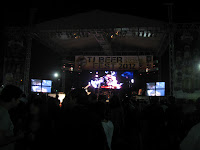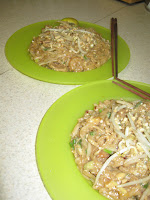Recently, TJ and I were invited to weekend family dinner where the matriarch served up homemade menudo and birria. Neither dish is a particular favorite of mine, but her concoctions were so good that I thought I should give them a second chance on my list of foreign recipes to try. In terms of cooking, menudo is not much different than pozole, which I made a while back. But I'd probably be more successful bringing back the Puerto Rican boy band than making tripe edible. Besides, cow flesh is more forgiving -- and tasty -- than cow stomach, so I thought I could give birria a shot.
Birria is more traditionally a meat stew, but here in Tijuana it is frequently a taco filling. In looking at recipes I decided to pick and choose some pieces from two. For the meat, I already had an eye of round, about a pound and a half, so I decided to simply add 1-1/2 pounds of ribs (left), using the meat combination from the stew recipe but the quantity from the filling one. I ignored both recipes in terms of preparation, opting to slow-cook the meat, for three hours on high, instead of watching a simmering pot all day. Within about 30 minutes, the stock was already beginning to form (right).
While the meat cooked, I prepped the peppers. And here, I made another recipe merge. I used most of the peppers from the taco recipe, except the California chiles, because, surprisingly, I couldn't find them in the store. So I selected guajillo ones, which were suggested in the stew recipe and are said to make a suitable substitute, in terms of their color, size, and heat. The guajillos are long, narrow, and red; the pasillas and anchos are both green, but the anchos are smaller and wrinklier (top left). After stemming and seeding the peppers (top right), which felt like using a letter opener to cut Fruit Roll-ups, the peppers soaked in water for about an hour (bottom left) before they were drained (bottom right), leaving a trail of orange-stained cookware (In the future, I'd suggest using a disposable dish to soften the chiles.)
From here on out, I stuck to the taco recipe, mainly because it simplifies the seasonings by using achiote paste, which contains many of the spices from the stew recipe. Plus, considering I shop at a Latino market all the time, I was able to easily find it, right by the ketchup. The tomato, onion, garlic, peppercorns, cumin seed, and achiote paste all went in the food processor first (top), creating a vibrantly scarlet sauce (bottom left). I thought that the chiles would add most of the color, but it seems the achiote paste is the key because the peppers merely deepened the red of the mixture (bottom right).
While the sauce waited during a work event, the meat rested, leaving it plenty cool to slice. I pulled out all of the meat first (top left), so I could scoop some broth for the sauce and store the rest for future recipes. A knife was on hand, but really the meat was so tender that I could just pull it apart (top right). The bones from the ribs had fallen off long before, so I just strained them out of the leftover stock. A cup (more like a cup and a half) of it went into the sauce, then the sauce and meat went back into the crockpot to simmer (bottom).
Actually, I was supposed to strain the sauce before putting it into the meat, but I forgot, and to be honest, the sauce was so thick that it seemed a shame to waste so much flavor. Possibly, the pepper skins made the mixture more bitter, but the only really noticeable effect was the occasional surprise bite into a peppercorn. TJ set up a complete condiment station of hot sauces, onions, cabbage, limes radishes, and cilantro (left). Still, I stuck to a common construction with dollops of meat on tortillas, topped with only onion, cilantro, and a squirt of lime.
I have to agree with TJ's assessment that it wasn't the greatest taco we've ever had. But, he admitted, it seemed like real birria, which both of us find somewhat bland (particularly TJ, who uses hot sauce like ketchup). For the leftovers, we plan to drop a good dose of seasoned salt into the meat, in the hopes that it will better suit our sodium-addicted American palates. We have some dignity, though, in that, no matter what, the tacos will not be smothered in shredded cheese.









































